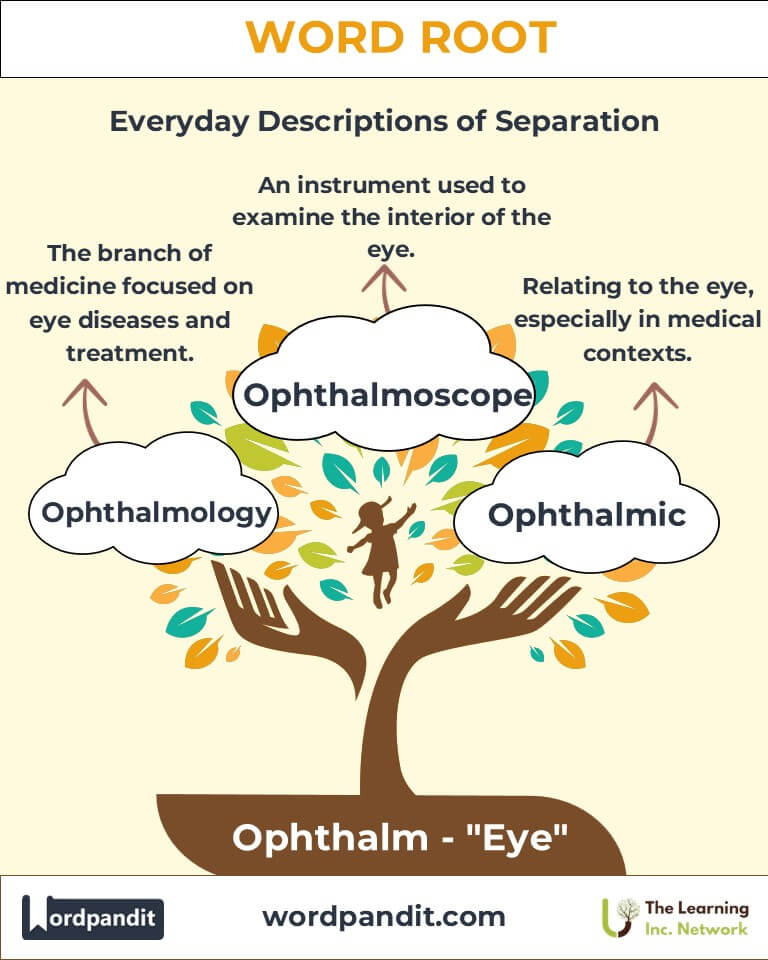Ophthalm: The Window to Vision in Language and Medicine
Discover the fascinating role of the word root "ophthalm," derived from the Greek word ophthalmos meaning "eye." From essential medical fields like ophthalmology to terms like ophthalmic, this root has illuminated the study of vision and its cultural significance.

Table of Contents
- Introduction: The Essence of Ophthalm
- Etymology and Historical Journey
- Mnemonic: Unlocking the Power of Ophthalm
- Common Ophthalm-Related Terms
- Ophthalm Through Time
- Ophthalm in Specialized Fields
- Illustrative Story: Ophthalm in Action
- Cultural Significance of the Ophthalm Root
- The Ophthalm Family Tree
- FAQs About the Ophtalm Word Root
- Test Your Knowledge: Ophtalm Word Root Quiz
- Conclusion: The Visionary Legacy of Ophthalm
Introduction: The Essence of Ophthalm
The human eye has often been called the "window to the soul" and is one of the most complex organs in the body. The root "ophthalm," pronounced OFF-thalm or OFF-thuhm, comes from the Greek word ophthalmos, meaning "eye." This root is central to many terms in medicine, particularly in fields focusing on vision and eye health. Whether describing a branch of medical science or tools for diagnosis, ophthalm underscores the importance of vision in life and language.

Etymology and Historical Journey
The root "ophthalm" traces back to ancient Greek, where ophthalmos was used to describe the physical eye. Early Greek philosophers and physicians, like Hippocrates, recognized the eye's significance in health and perception. With the rise of medical science during the Renaissance, ophthalmos gave rise to modern terms like ophthalmology—the scientific study of the eye. This root seamlessly integrated into English and other languages, becoming foundational in medical terminology.
Mnemonic: Unlocking the Power of Ophthalm
Imagine a glowing, magnified eye surrounded by diagnostic tools like glasses and microscopes.
Mnemonic Device:
"Ophthalm leads the eye to light and clarity."
Common Ophthalm-Related Terms
- Ophthalmology (off-thal-MOL-uh-jee):
Definition: The branch of medicine concerned with the study and treatment of eye disorders.
Example: "Dr. Carter specialized in ophthalmology to help patients with cataracts." - Ophthalmic (off-THAL-mik):
Definition: Relating to the eye.
Example: "The ophthalmic ointment was prescribed for conjunctivitis." - Ophthalmoscope (off-THAL-muh-scope):
Definition: An instrument used to examine the interior of the eye.
Example: "The ophthalmologist used an ophthalmoscope to check for retinal damage." - Exophthalmos (ek-sof-THAL-muhs):
Definition: Abnormal protrusion of the eyeball.
Example: "Exophthalmos is a common symptom of thyroid eye disease." - Photophthalmia (fo-tof-THAL-mee-uh):
Definition: Eye inflammation caused by exposure to intense light.
Example: "Photophthalmia can occur after prolonged exposure to welding arcs."
Ophthalm Through Time
- Ancient Medicine: Greek and Roman scholars documented the anatomy and physiology of the eye, laying the groundwork for terms like ophthalmos.
- Renaissance Advances: The invention of the ophthalmoscope in the 19th century revolutionized eye care.
- Modern Era: Developments in ophthalmic surgery and diagnostics continue to expand the scope of ophthalm-related fields.
Ophthalm in Specialized Fields
- Medicine:
Ophthalmology: Focuses on diagnosing and treating conditions like glaucoma and macular degeneration.
Ophthalmic Surgery: Includes procedures like LASIK and cataract removal. - Technology:
Ophthalmic Devices: Innovations like intraocular lenses (IOLs) improve vision restoration. - Public Health:
Vision Screening Programs: Address global challenges like preventable blindness.
Illustrative Story: Ophthalm in Action
Dr. Li, an ophthalmologist, was determined to combat preventable blindness in underserved regions. Armed with portable ophthalmoscopes, she traveled to remote villages, screening hundreds of patients. One day, she met Ahmed, a young boy whose declining vision threatened his future. Diagnosing cataracts, Dr. Li arranged for surgery, restoring his sight and giving him a new lease on life. This moment underscored the transformative power of ophthalm-related care.
Cultural Significance of the Ophthalm Root
Eyes symbolize perception, awareness, and truth across cultures. From the "Eye of Horus" in ancient Egypt to the watchful eyes in modern literature, vision holds deep symbolic value. Words rooted in ophthalm bridge scientific precision and cultural meaning, highlighting the eye's central role in human experience.

The Ophthalm Family Tree
- Opt- (sight, vision):
- Optical: Relating to sight or light.
- Optometrist: A specialist in measuring vision.
- Ocul- (Latin for eye):
- Ocular: Pertaining to the eye.
- Binoculars: Devices for viewing distant objects with both eyes.
- Vis- (see):
- Visionary: Inspired by foresight.
- Visible: Able to be seen.
FAQs About the Ophthalm Word Root
Q: What does the root "ophthalm" mean?
A: The root "ophthalm" means "eye" and comes from the Greek word ophthalmos. It is the basis for many medical and scientific terms related to vision and eye care. This root reflects the eye's central role in both perception and health.
Q: How does "ophthalmic" differ from "ocular"?
A: Both terms refer to the eye, but they are used in slightly different contexts. "Ophthalmic" is primarily used in medical terminology to describe conditions, medications, or treatments specifically related to the eyes (e.g., ophthalmic drops). "Ocular" is broader, often referring to general aspects of the eye, including anatomy and functions.
Q: What is the role of an ophthalmologist?
A: An ophthalmologist is a medical doctor specializing in diagnosing and treating eye diseases. Unlike optometrists, they can perform surgeries such as cataract removal or LASIK and treat complex conditions like glaucoma or retinal disorders.
Q: What is an ophthalmoscope, and what is it used for?
A: An ophthalmoscope is a handheld instrument used to examine the interior structures of the eye, particularly the retina and optic nerve. It helps detect conditions like diabetic retinopathy, macular degeneration, or optic nerve damage.
Q: What causes exophthalmos, and how is it treated?
A: Exophthalmos refers to the abnormal protrusion of the eyeballs, often caused by underlying conditions like thyroid eye disease (Graves' disease). Treatment focuses on managing the root cause, such as addressing thyroid imbalance or, in severe cases, performing orbital decompression surgery.
Q: How is ophthalmology different from optometry?
A: Ophthalmology is a branch of medicine that deals with diagnosing, treating, and performing surgery for eye diseases. Optometry, on the other hand, focuses on vision correction, prescribing glasses or contact lenses, and identifying eye health issues that may require referral to an ophthalmologist.
Q: What is photophthalmia, and who is at risk?
A: Photophthalmia is an eye condition caused by exposure to intense light, such as sunlight, welding arcs, or lasers. It results in inflammation of the cornea and conjunctiva. Welders, skiers, and people working in bright environments are particularly at risk. Wearing protective eyewear is crucial to prevent this condition.
Test Your Knowledge: Ophthalm Word Root Quiz
1. What does the root "ophthalm" mean?
2. Which term refers to the study of eye diseases?
3. What is an ophthalmoscope used for?
4. What does "exophthalmos" describe?
5. What is photophthalmia caused by?
Conclusion: The Visionary Legacy of Ophthalm
The root "ophthalm" reflects the eye's profound significance in medicine, culture, and everyday life. As advances in ophthalmic care continue to evolve, this root reminds us of the timeless importance of vision in understanding and navigating the world.












